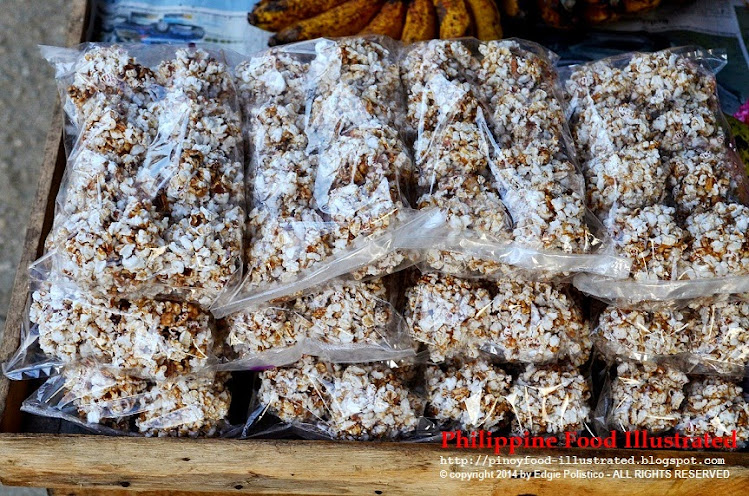buti-buti -/bu-tî bu-tî, buti-butî/ (Cuyonon [Palaweño] snack) [n.] Cuyunon puffed rice.
The ampao (puffed rice) of Cuyo island, found in a group of islands in the northeastern seas of Palawan. This ampao is mixed with caramelized sugar and molded into small balls.

I found these packs of buti-buti peddled by Pastor Abad in the public market of Roxas, Palawan. I thought the balls were crumbled popcorn. But a closer look told me they are puffed big kernels of rice. I am amazed there is such kind of rice in the country with big kernels and grown in that small Cuyo island.
Buti-buti is made with native rice grown only on Cuyo island. The rice is dehulled manually using alho and lusong (wooden pestle and mortar) which produces barely polished native rice grains, with reddish or brown-colored bran intact.
The dehulled grains are pan-roasted until each grain would burst open to become like popcorn. Then muscovado sugar is melted (caramelized) in a pot with a little amount of water and the puffed rice is added in and mixed to combine with the caramelized sugar that served as the sweetener and binder of buti-buti. The caramel-coated puffed rice is then molded by hands into small balls, about the size of a golf ball.
Unlike popcorn, this native puffed rice is quite dense and the outer layer of the kernel is leathery that needs a lot of chewing to fully masticate. Only by chewing it well that you can savor the true taste of buti-buti.
These balls of buti-buti are delicate to handle. It sticks to your finger and easily crumbles when pressed between fingers or even when poked as shown in the next photos.
Due to a very limited supply of the kind of rice used, buti-buti is mostly reserved only to be prepared during festival celebrations on the island or on other special occasions, depending on the availability of the rice.
I got this authentic product of Cuyo, Palawan just an hour after it arrived from Cuyo island. Back then, it would take about two days to transport buti-buti to Roxas, Palawan. Cuyo is a small island off the northeastern sea of mainland Palawan. It's only in Cuyo island that you can find this rice delicacy.
The variety of native rice used in making buti-buti is the heirloom rice of Cuyo island. Growing this rice is seasonal and the grains are scarcely available, mostly only during harvest season or while stock last. This explains why the small pack of buti-buti I bought cost much.
Rice farming in Cuyo island relies only on rain and sunshine to sustain its production. The rice is grown organically and without using synthetic pesticides.
I still kept on wondering how the rice subsists on that small island.
The name buti-buti is derived from the Ilonggo word butî which means the popping sound of bursting grains or kernels when roasting rice to make puffed rice or roasting maize to make popped corn.
Related posts:
Ampaw
All photos by Edgie Polistico are copyrighted. ALL RIGHTS RESERVED.
If you liked this post and our site, share it.
Let us know your opinion on the subject. Feel free to comment in the comment section, below. It is important for us to know what you think.
Tell us what other topics you would like us to write, share, and discuss about.
Continue to follow my blogs. You can also follow and learn more by joining us in our Facebook group. Have more bits and pieces about our kind of food, ingredients, and ways of cooking, dining, and knowing food culture across the 7,641 islands of the Philippines.
Encouragement and enthusiasm are not enough. I also need moral support, prayers, and anything else that can uplift my spirit and keep my good reasons. Keep them coming. All I know is that I am happy with what I am sharing and giving away. If you are pleased and happy with what I am doing, just smile and please share the happiness. Keep sharing and include to share the PHILIPPINE FOOD ILLUSTRATED. I feel energized when my blog becomes one of the reasons why you are happy and smiling.
Edgie Polistico
|










